Effects of the Gully Land Consolidation Project on Runoff and Peak Flow Rate on the Loess Plateau, China
Abstract
:1. Introduction
2. Materials and Methods
2.1. Study Area
2.2. Data Sources
2.3. Surface Runoff and Peak Flow Rate Simulation
2.4. Model Calibration and Validation
2.5. Hydrological Connectivity
3. Results
3.1. The Results of Calibration and Validation
3.2. Simulated Surface Runoff
3.3. Estimated Peak Flow Rate
4. Discussion
4.1. GLC Reduced Surface Runoff
4.2. GLC Reduced the Peak Flow Rate
4.3. Implication
5. Conclusions
- (1)
- The GLC reduced mean event surface runoff, and the efficiency in reducing runoff ranged between 6.2% and 24.7%. The highest efficiency of GLC at reducing runoff was found under light rain events. The lowest efficiency of GLC at reducing runoff was found under heavy rain events and the extraordinary storm event.
- (2)
- After the GLC, the annual surface runoff decreased by 7.63%, 12.04% and 4.45% in the wet year, normal year and dry year, respectively. The order of the GLC’s efficiency in reducing annual surface runoff from large to small was as follows: normal year > wet year > dry year.
- (3)
- The GLC reduced the peak flow rate by 8.1–30.2%. The impact of the GLC on the peak flow rate was greater under light rains than under extraordinary storms. Moreover, the GLC prolonged the time to peak flow rate.
- (4)
- The GLC affected runoff and peak flow rates by changing slope gradients, hydrological connectivity and land use types.
Author Contributions
Funding
Institutional Review Board Statement
Informed Consent Statement
Data Availability Statement
Acknowledgments
Conflicts of Interest
References
- Zhang, Y.; Peng, C.H.; Li, W.Z.; Tian, L.X.; Zhu, Q.Q.; Chen, H.; Fang, X.Q.; Zhang, G.L.; Liu, G.B.; Mu, X.M.; et al. Multiple afforestation programs accelerate the greenness in the ‘Three North’ region of China from 1982 to 2013. Ecol. Indic. 2016, 61, 404–412. [Google Scholar] [CrossRef]
- Chen, C.; Park, T.; Wang, X.H.; Piao, S.L.; Xu, B.D.; Chaturvedi, R.K.; Fuchs, R.; Brovkin, V.; Ciais, P.; Fensholt, R.; et al. China and India lead in greening of the world through land-use management. Nat. Sustain. 2019, 2, 122–129. [Google Scholar] [CrossRef] [PubMed]
- Gong, J.; Chen, L.; Fu, B.; Huang, Y.; Huang, Z.; Peng, H. Effect of land use on soil nutrients in the Loess Hilly area of the Loess Plateau, China. Land Degrad. Dev. 2006, 17, 453–465. [Google Scholar] [CrossRef]
- Xie, C.; Wang, J.N.; Peng, W.; Zhang, K.; Liu, J.J.; Yu, B.C.; Jiang, X.L. The New Round of CCFP: Policy Improvement and Implementation Wisdom—Based on the Results of Social and Economic Benefit Inventory of CCFP in 2015. For. Econ. 2016, 38, 43–51+81. (In Chinese) [Google Scholar]
- Bai, L.C.; Wang, N.; Jiao, J.Y.; Chen, Y.X.; Tang, B.Z.; Wang, H.L.; Chen, Y.L.; Yan, X.Q.; Wang, Z.J. Soil erosion and sediment interception by check dams in a watershed for an extreme rainstorm on the Loess Plateau, China. Int. J. Sediment Res. 2020, 35, 408–416. [Google Scholar] [CrossRef]
- Lv, Y.H.; Fu, B.J.; Feng, X.M.; Yuan, Z.; Liu, Y.; Chang, R.Y.; Sun, G.; Wu, B.F. A Policy-Driven Large Scale Ecological Restoration: Quantifying Ecosystem Services Changes in the Loess Plateau of China. PLoS ONE 2012, 7, e31782. [Google Scholar]
- Wang, S.; Wang, H.Y.; Xie, Y.S.; Luo, H. Evaluation of ecological service function of soil conservation before and after Grain for Green project in Yan’an city. Res. Soil Water Conserv. 2019, 26, 283–286. (In Chinese) [Google Scholar]
- Ma, J.F.; Chen, Y.P.; Wang, H.J.; Wang, H.; Wu, J.H.; Su, C.C.; Xu, C. Newly created farmland should be artificially ameliorated to sustain agricultural production on the Loess Plateau. Land Degrad. Dev. 2020, 31, 2565–2576. [Google Scholar] [CrossRef]
- Zhao, Y.L.; Wang, Y.Q.; Wang, L.; Zhang, X.Y.; Yu, Y.L.; Jin, Z.; Lin, H.; Chen, Y.P.; Zhou, W.J.; An, Z.S. Exploring the role of land restoration in the spatial patterns of deep soil water at watershed scales. Catena 2019, 172, 387–396. [Google Scholar] [CrossRef]
- Bronstert, A.; Vollmer, S.; Ihringer, J. A review of the impact of land consolidation on runoff production and flooding in Germany. Phys. Chem. Earth 1995, 20, 321–329. [Google Scholar] [CrossRef]
- Vitikainen, A. An Overview of Land Consolidation in Europe. Nord. J. Surv. Real Estate Res. 2004, 1, 25–44. [Google Scholar]
- Liu, S.L.; Dong, Y.H.; Li, D.; Liu, Q.; Wang, J.; Zhang, X.L. Effects of different terrace protection measures in a sloping land consolidation project targeting soil erosion at the slope scale. Ecol. Eng. 2013, 53, 46–53. [Google Scholar] [CrossRef]
- Hoeksema, R.J. Three stages in the history of land reclamation in the Netherlands. Irrig. Drain. 2007, 56, S113–S126. [Google Scholar] [CrossRef]
- Pašakarnis, G.; Morley, D.; Malienė, V. Rural development and challenges establishing sustainable land use in Eastern European countries. Land Use Policy 2013, 30, 703–710. [Google Scholar] [CrossRef]
- He, M.N.; Wang, Y.Q.; Tong, Y.P.; Zhao, Y.L.; Qiang, X.K.; Song, Y.G.; Wang, L.; Song, Y.; Wang, G.D.; He, C.X. Evaluation of the environmental effects of intensive land consolidation: A field-based case study of the Chinese Loess Plateau. Land Use Policy 2020, 94, 104523. [Google Scholar] [CrossRef]
- Ishii, A. The methods to consolidate scattered tenanted lots into large rice paddy lots by the land consolidation projects in Japan. Paddy Water Environ. 2005, 3, 225–233. [Google Scholar] [CrossRef]
- Van den Noort, P.C. Land consolidation in the Netherlands. Land Use Policy 1987, 4, 11–13. [Google Scholar] [CrossRef]
- Liu, Q.; Wang, Y.Q.; Zhang, J.; Chen, Y.P. Filling Gullies to Create Farmland on the Loess Plateau. Environ. Sci. Technol. 2013, 47, 7589–7590. [Google Scholar] [CrossRef]
- Zglobicki, W.; Baran-Zgłobicka, B.; Gawrysiak, L.; Telecka, M. The impact of permanent gullies on present-day land use and agriculture in loess areas (E. Poland). Catena 2015, 126, 28–36. [Google Scholar] [CrossRef]
- Zhang, X.C.; Li, Y.R.; Liu, Y.S.; Huang, Y.X.; Wang, Y.S.; Lu, Z. Characteristics and prevention mechanisms of artificial slope instability in the Chinese Loess Plateau. Catena 2021, 207, 105621. [Google Scholar] [CrossRef]
- Wang, J.; Hu, Y.; Li, P.; Bai, Q.J. Spatial and temporal variations of habitat quality under the background of gully control and land consolidation in Yan’an China. Acta Ecol. Sin. 2022, 42. (In Chinese) [Google Scholar]
- Zhang, X.B.; Jin, Z. Gully land consolidation project in Yan’an is inheritance and development of wrap land dam project on the Loess Plateau. J. Earth Environ. 2015, 6, 261–264. (In Chinese) [Google Scholar]
- Liu, Y.S.; Li, Y.R. Engineering philosophy and design scheme of gully land consolidation in Loess Plateau. Trans. Chin. Soc. Agric. Eng. 2017, 33, 1–9. (In Chinese) [Google Scholar]
- Han, X.L.; Lv, P.Y.; Zhao, S.; Sun, Y.; Yan, S.Y.; Wang, M.H.; Han, X.N.; Wang, X.R. The Effect of the Gully Land Consolidation Project on Soil Erosion and Crop Production on a Typical Watershed in the Loess Plateau. Land 2018, 7, 113. [Google Scholar] [CrossRef]
- Mihara, M. Effects of agricultural land consolidation on erosion processes in semi-mountainous paddy fields of Japan. J. Agric. Eng. Res. 1996, 64, 237–247. [Google Scholar] [CrossRef]
- Lou, X.Y.; Gao, J.E.; Han, S.Q.; Guo, Z.H.; Yin, Y. Influence of Land Consolidation Engineering of Gully Channel on Watershed Runoff Yield and Concentration in Loess Hilly and Gully Region. Water Resour. Power 2016, 34, 23–27. (In Chinese) [Google Scholar]
- Sun, P.C.; Gao, J.E.; Han, S.Q.; Yin, Y.; Zhou, M.F. Simulation study on the effects of typical gully land consolidation on runoff-sediment-nitrogen emissions in the loess hilly-gully region. J. Agro-Environ. Sci. 2017, 36, 1177–1185. [Google Scholar]
- Kang, Y.C.; Gao, J.E.; Shao, H.; Zhang, Y.Y.; Li, J.; Gao, Z. Evaluating the flow and sediment effects of gully land consolidation on the Loess Plateau, China. J. Hydrol. 2021, 600, 126535. [Google Scholar] [CrossRef]
- Guo, Z.H.; Gao, J.N.; Sun, P.C.; Dou, S.H.; Li, J.; Lou, X.Y.; Wang, H.; Ahmad, R.; Gao, Z. Influence of Gully Land Consolidation on Phreatic Water Transformation in the Loess Hilly and Gully Region. Water 2021, 13, 538. [Google Scholar] [CrossRef]
- Wang, Y.Q.; Sun, H.; Zhao, Y.L. Characterizing spatial-temporal patterns and abrupt changes in deep soil moisture across an intensively managed watershed. Geoderma 2019, 341, 181–194. [Google Scholar] [CrossRef]
- Wei, W.; Chen, L.D.; Fu, B.J.; Huang, Z.L.; Wu, D.P.; Gui, L.D. The effect of land uses and rainfall regimes on runoff and soil erosion in the semi-arid loess hilly area, China. J. Hydrol. 2007, 335, 247–258. [Google Scholar] [CrossRef]
- Fang, H.Y. Responses of Runoff and Soil Loss to Rainfall Regimes and Soil Conservation Measures on Cultivated Slopes in a Hilly Region of Northern China. Int. J. Environ. Res. Public Health 2021, 18, 2102. [Google Scholar] [CrossRef]
- Zheng, H.J.; Nie, X.F.; Liu, Z.; Mo, M.H.; Song, Y.J. Identifying optimal ridge practices under different rainfall types on runoff and soil loss from sloping farmland in a humid subtropical region of Southern China. Agric. Water Manag. 2021, 255, 107043. [Google Scholar] [CrossRef]
- Lin, Q.T.; Xu, Q.; Wu, F.Q.; Li, T.T. Effects of wheat in regulating runoff and sediment on different slope gradients and under different rainfall intensities. Catena 2019, 183, 104196. [Google Scholar] [CrossRef]
- Li, Y.S.; Han, S.F.; Wang, Z.H. Soil water properties and its zonation in the Loess Plateau. Res. Soil Water Conserv. 1985, 2, 1–17. (In Chinese) [Google Scholar]
- Xie, B.N.; Jia, X.X.; Qin, Z.F.; Shen, J.; Chang, Q.R. Vegetation dynamics and climate change on the Loess Plateau, China: 1982–2011. Reg. Environ. Chang. 2016, 16, 1583–1594. [Google Scholar] [CrossRef]
- Chow, V.T.; Maidment, D.R.; Mays, L.W. Applied Hydrology; McGraw-Hill, Inc.: New York, USA, 1988. [Google Scholar]
- GB/T 28592-2012; Grade of Precipitation. China Meteorological Administration: Beijing, China, 1 August 2012.
- Rawat, K.S.; Singh, S.K. Estimation of Surface Runoff from Semi-arid Ungauged Agricultural Watershed Using SCS-CN Method and Earth Observation Data Sets. Water Conserv. Sci. Eng. 2017, 1, 233–247. [Google Scholar] [CrossRef]
- Shi, W.H.; Huang, M.B.; Gongadze, K.; Wu, L.H. A Modified SCS-CN Method Incorporating Storm Duration and Antecedent Soil Moisture Estimation for Runoff Prediction. Water Resour. Manag. 2017, 31, 1713–1727. [Google Scholar] [CrossRef]
- Nagarajan, N.; Poongothai, S. Spatial Mapping of Runoff from a Watershed Using SCS-CN Method with Remote Sensing and GIS. J. Hydrol. Eng. 2012, 17, 1268–1277. [Google Scholar] [CrossRef]
- Ajmal, M.; Kim, T.W. Quantifying Excess Stormwater Using SCS-CN-Based Rainfall Runoff Models and Different Curve Number Determination Methods. J. Irrig. Drain. Eng. 2015, 141, 04014058. [Google Scholar] [CrossRef]
- Al-Juaidi, A.E.M. A simplified GIS-based SCS-CN method for the assessment of land-use change on runoff. Arab. J. Geosci. 2018, 11, 269. [Google Scholar]
- Singh, P.K.; Yaduvanshi, B.K.; Patel, S.; Ray, S. SCS-CN Based Quantification of Potential of Rooftop Catchments and Computation of ASRC for Rainwater Harvesting. Water Resour. Manag. 2013, 27, 2001–2012. [Google Scholar] [CrossRef]
- Niyazi, B.; Khan, A.A.; Masoud, M.; Elfeki, A.; Basahi, J.; Zaidi, S. Optimum parametrization of the soil conservation service (SCS) method for simulating the hydrological response in arid basins. Geomat. Nat. Hazards Risk 2022, 13, 1482–1509. [Google Scholar] [CrossRef]
- Yousuf, A.; Bhardwaj, A. Development and application of travel time based gridded runoff and sediment yield model. Int. J. Environ. Sci. Technol. 2021. [Google Scholar] [CrossRef]
- Al-Ghobari, H.; Dewidar, A.; Alataway, A. Estimation of Surface Water Runoff for a Semi-Arid Area Using RS and GIS-Based SCS-CN Method. Water 2020, 12, 1924. [Google Scholar] [CrossRef]
- Jiao, P.J.; Xu, D.; Wang, S.L.; Yu, Y.D.; Han, S.L. Improved SCS–CN Method Based on Storage and Depletion of Antecedent Daily Precipitation. Water Resour. Manag. 2015, 29, 4753–4765. [Google Scholar] [CrossRef]
- Jaiswal, R.K.; Yadav, R.N.; Lohani, A.K.; Tiwari, H.L.; Yadav, S. Water balance modeling of Tandula (India) reservoir catchment using SWAT. Arab. J. Geosci. 2020, 13, 148. [Google Scholar] [CrossRef]
- Knisel, W.G.; Douglas-Mankin, K.R. CREAMS/GLEAMS: Model Use, Calibration, And Validation. Trans. ASABE 2012, 55, 1291–1302. [Google Scholar] [CrossRef]
- Xiao, B.; Wang, Q.H.; Fan, J.; Han, F.P.; Dai, Q.H. Application of the SCS-CN Model to Runoffff Estimation in a Small Watershed with High Spatial Heterogeneity. Pedosphere 2011, 21, 738–749. [Google Scholar] [CrossRef]
- Fu, S.; Zhang, G.; Wang, N.; Luo, L. Initial Abstraction Ratio In The Scs-Cn Method In The Loess Plateau Of China. Trans. ASABE 2011, 54, 163–169. [Google Scholar] [CrossRef]
- Gao, G.Y.; Fu, B.J.; Lv, Y.H.; Liu, Y.; Wang, S.; Zhou, J. Coupling the modified SCS-CN and RUSLE models to simulate hydrological effects of restoring vegetation in the Loess Plateau of China. Hydrol. Earth Syst. Sci. 2012, 16, 2347–2364. [Google Scholar] [CrossRef]
- Shi, W.H.; Wang, N.; Wang, M.M.; Li, D.H. Revised runoff curve number for runoff prediction in the Loess Plateau of China. Hydrol. Process 2021, 35, e14390. [Google Scholar] [CrossRef]
- Soil Conservation Service. Section 4: Hydrology. In National Engineering Handbook; US Soil Conservation Service: Washington, DC, USA, 1972. [Google Scholar]
- Verma, S.; Singh, P.K.; Mishra, S.K.; Jain, S.K.; Berndtsson, R.; Singh, A.; Verma, R.K. Simplified SMA-inspired 1-parameter SCS-CN model for runoff estimation. Arab. J. Geoences 2018, 11, 420. [Google Scholar] [CrossRef]
- Mishra, S.K.; Jain, M.K.; Babu, P.S.; Venugopal, K.; Kaliappan, S. Comparison of AMC-dependent CN-conversion formulae. Water Resour. Manag. 2008, 22, 1409–1420. [Google Scholar] [CrossRef]
- USDA. National Engineering Handbook Hydrology Chapters; USDA: Washington, DC, USA, 1997.
- Fu, S.H.; Wei, X.; Zhang, G.H. Estimation of peak flows from small watersheds on the Loess Plateau of China. Hydrol. Processes 2008, 22, 4233–4238. [Google Scholar] [CrossRef]
- United States Department of Agriculture. Chapter 16 Hydrology, National Engineering Handbook. 2007. Available online: https://www.nrcs.usda.gov/wps/portal/nrcs/detailfull/national/water/manage/hydrology/?cid=stelprdb1043063 (accessed on 1 July 2022).
- Nash, J.E.; Sutcliffe, J.V. River flow forecasting through conceptual models: Part 1. A discussion of principles. J. Hydrol. 1970, 10, 282–290. [Google Scholar] [CrossRef]
- Singh, J.; Knapp, H.V.; Arnold, J.G.; Demissie, M. Hydrologic modeling of the Iroquois River watershed using HSPF and SWAT. J. Am. Water Resour. Assoc. 2005, 41, 343–360. [Google Scholar] [CrossRef]
- Pringle, C.M. Hydrological connectivity and the management of biological reserves: A global perspective. Ecol. Appl. 2001, 11, 981–998. [Google Scholar]
- Bracken, L.J.; Croke, J. The concept of hydrological connectivity and its contribution to understanding runoff–dominated geomorphic systems. Hydrol. Processes 2007, 21, 1749–1763. [Google Scholar] [CrossRef]
- Moriasi, D. Model evaluation guidelines for systematic quantification of accuracy in watershed simulations. Trans. ASABE 2007, 50, 885–900. [Google Scholar] [CrossRef]
- Ji, Q.Q.; Gao, Z.; Li, X.Y.; Gao, J.N.; Zhang, G.G.; Ahmad, R.; Liu, G.; Zhang, Y.Y.; Li, W.Z.; Zhou, F.F.; et al. Erosion Transportation Processes as Influenced by Gully Land Consolidation Projects in Highly Managed Small Watersheds in the Loess Hilly-Gully Region; China. Water 2021, 13, 1540. [Google Scholar] [CrossRef]
- Chaplot, V.A.M.; Bissonnais, Y.L. Runoff features for interrill erosion at different rainfall intensities; slope lengths; and gradients in an agricultural loessial hillslope. Soil Sci. Soc. Am. J. 2003, 67, 844–851. [Google Scholar] [CrossRef]
- Fox, D.M.; Bryan, R.B.; Price, A.G. The influence of slope angle on final infiltration rate for interrill conditions. Geoderma 1997, 80, 181–194. [Google Scholar] [CrossRef]
- Zhang, F.M.; Du, L.L.; Yuan, Y.; Wang, S.H.; Guo, S.L. Effects oof soil erosion and deposition on soil physical and biochemical properties. J. Soil Water Conserv. 2021, 35, 161–167. (In Chinese) [Google Scholar]
- Zheng, F.L.; Zhang, X.C.; Wang, J.X.; Flanagan, D.C. Assessing applicability of the WEPP hillslope model to steep landscapes in the northern Loess Plateau of China. Soil Tillage Res. 2020, 197, 104492. [Google Scholar] [CrossRef]
- Wainwright, J.; Parsons, A.J. The effect of temporal variations in rainfall on scale dependency in runoff coefficients. Water Resour. Res. 2002, 38, 7-1-7-10. [Google Scholar] [CrossRef]
- Jin, Z.; Guo, L.; Wang, Y.Q.; Yu, Y.L.; Lin, H.; Chen, Y.P.; Chu, G.C.; Zhang, J.; Zhang, N.P. Valley reshaping and damming induce water table rise and soil salinization on the Chinese Loess Plateau. Geoderma 2019, 339, 115–125. [Google Scholar] [CrossRef]
- Yin, X.X.; Chen, L.W.; He, J.D.; Feng, X.Q.; Zeng, W. Characteristics of groundwater flow field after land creation engineering in the hilly and gully area of the Loess Plateau. Arab. J. Geosci. 2016, 9, 646. [Google Scholar] [CrossRef]
- Evrard, O.; Persoons, E.; Vandaele, K.; van Wesemael, B. Effectiveness of erosion mitigation measures to prevent muddy floods: A case study in the Belgian loam belt. Agric. Ecosyst. Environ. 2007, 118, 149–158. [Google Scholar] [CrossRef]
- Meijles, E.W.; Williams, A. Observation of regional hydrological response during time periods of shifting policy. Appl. Geogr. 2012, 34, 456–470. [Google Scholar] [CrossRef]
- Knisel, W.G.E. CREAMS: A Field Scale Model for Chemicals, Runoff, and Erosion from Agricultural Management Systems; Conservation Research Report No. 26; Dept. of Agriculture: Washington, DC, USA, 1980.
- Liu, B.Y.; Wang, D.A.; Fu, S.H.; Cao, W.H. Estimation of Peak Flow Rates for Small Drainage Areas. Water Resour. Manag. 2017, 31, 1635–1647. [Google Scholar] [CrossRef]
- Wang, Z.L.; Huang, X.H.; Zhang, Z.G.; Niu, Z.H.; Tian, F.X. Experimental Study of Runoff Processes on Bare Loess Hillslope. Bull. Soil Water Conserv. 2005, 4, 1–4. (In Chinese) [Google Scholar]
- Deng, L.Z.; Zhang, L.P.; Fan, X.J.; Wu, Y.H.; Sun, T.Y.; Fei, K. Characteristica of runoff and sediment yield under different rainfall intensities and slope gradients in erosion weather granite area. Trans. Chin. Soc. Agric. Eng. 2018, 34, 143–150. (In Chinese) [Google Scholar]
- Hessel, R. Effects of grid cell size and time step length on simulation results of the Limburg soil erosion model (LISEM). Hydrol. Processes 2010, 19, 3037–3049. [Google Scholar] [CrossRef]
- Tian, P.; Qiu, H.R.; Feng, Y.; Wu, H.Y.; Wu, T.N. Effects of Rainfall Intensity and Slope Gradient on Runoff and Sediement Production and Erosion Dynamic Process on Red Soil Slope. Res. Soil Water Conserv. 2020, 27, 106997. (In Chinese) [Google Scholar]
- Hooke, J.; Souza, J.; Marchamalo, M. Evaluation of connectivity indices applied to a Mediterranean agricultural catchment. Catena 2021, 207, 105713. [Google Scholar] [CrossRef]
- Yaslioglu, E.; Arici, I.; Kuscu, H.; Gundogdu, K.S.; Aslan, S.T.A.; Kirmikil, M. Adoption factors of irrigation systems whose projects are synchronized with land consolidation. Kuwait J. Sci. Eng. 2008, 35, 71–80. [Google Scholar]
- Albrecht, J.; Hartmann, T. Land for flood risk management—Instruments and strategies of land management for polders and dike relocations in Germany. Environ. Sci. Policy 2021, 118, 36–44. [Google Scholar] [CrossRef]
- Caldas, A.M.; Pissarra, T.C.T.; Costa, R.C.A.; Neto, F.C.R.; Zanata, M.; Parahyba, R.D.B.V.; Fernandes, L.F.S.; Pacheco, F.A.L. Flood Vulnerability, Environmental Land Use Conflicts, and Conservation of Soil and Water: A Study in the Batatais SP Municipality, Brazil. Water 2018, 10, 1357. [Google Scholar] [CrossRef]
- IPCC. Climate Change 2014: Synthesis Report. Contribution of Working Groups, I., II and III to the Fifth Assessment Report of the Intergovernmental Panel on Climate Change; IPCC: Geneva, Switzerland, 2014. [Google Scholar]
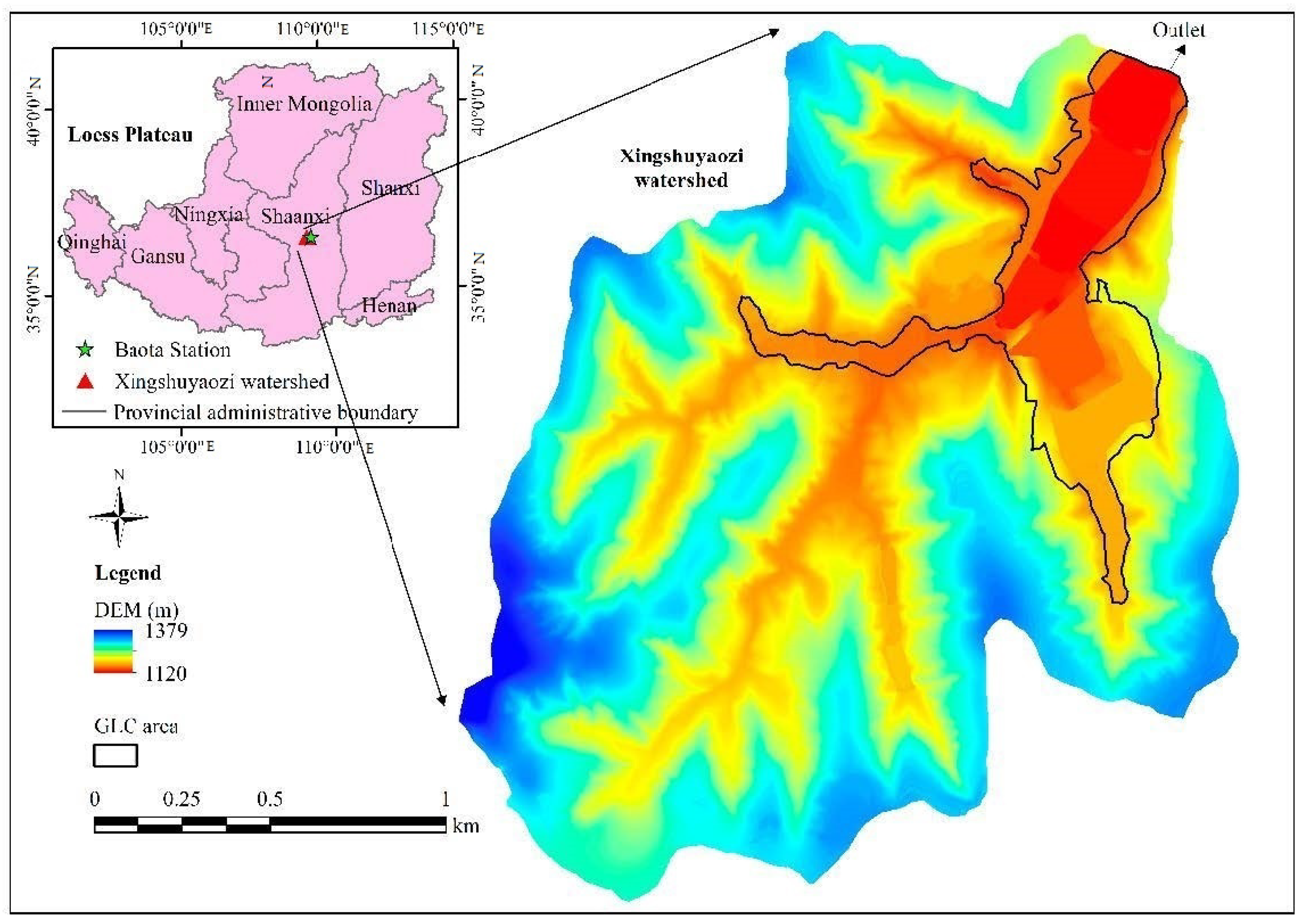


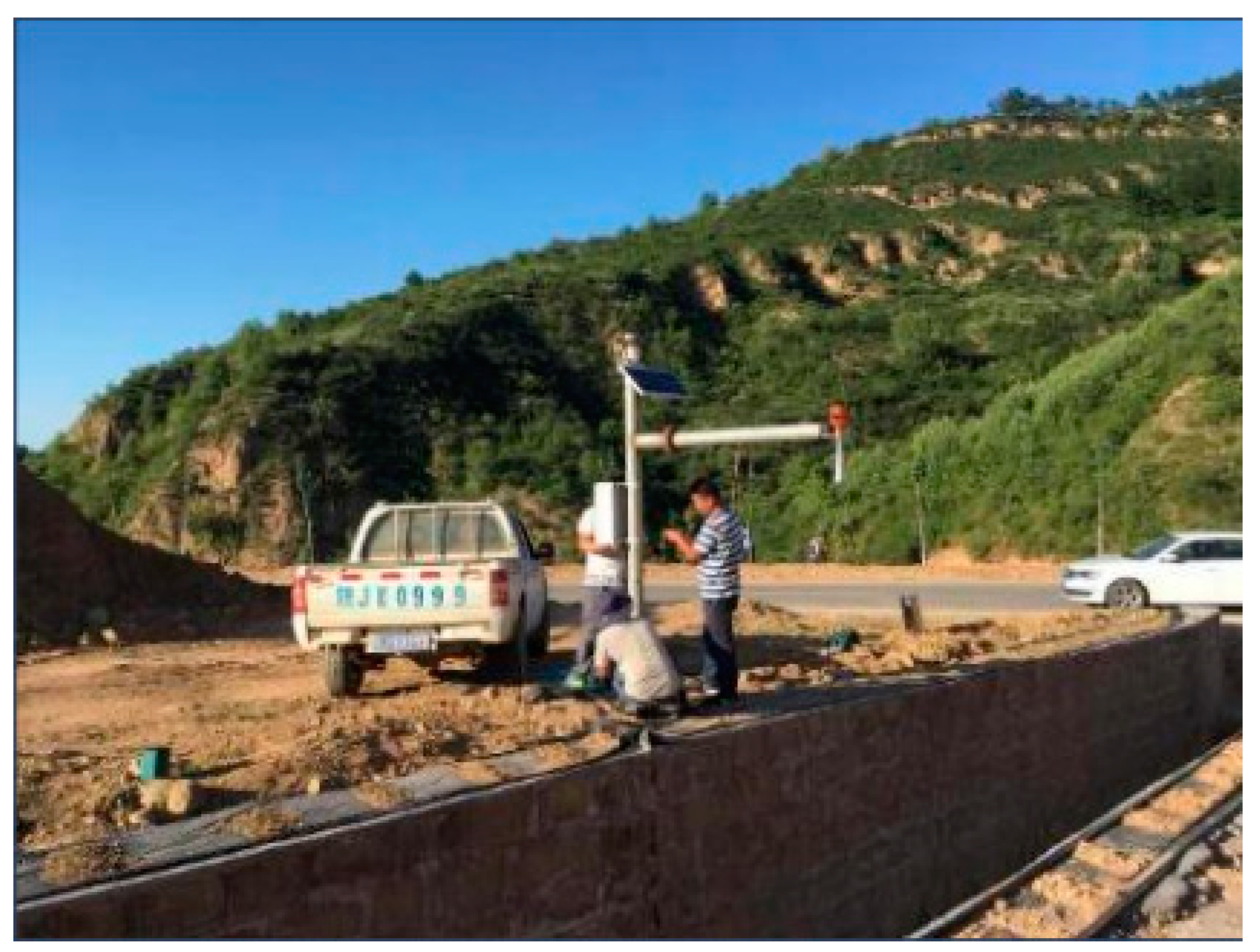


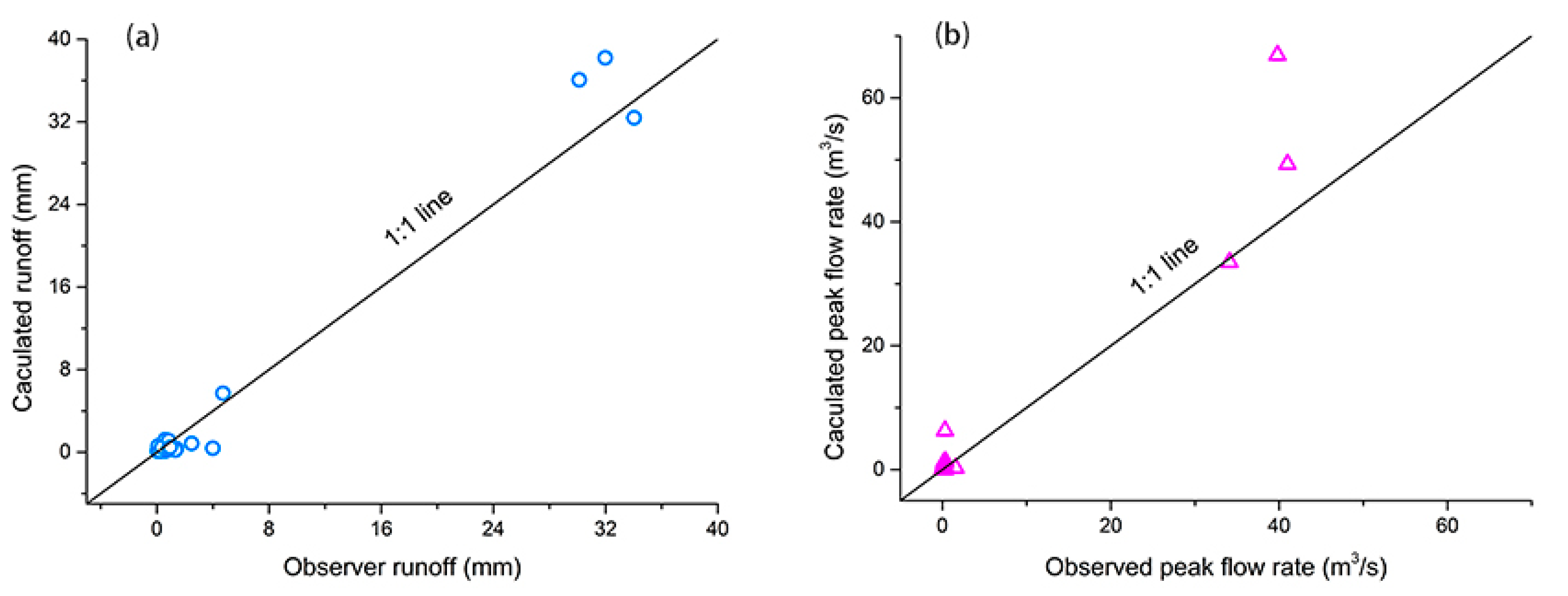
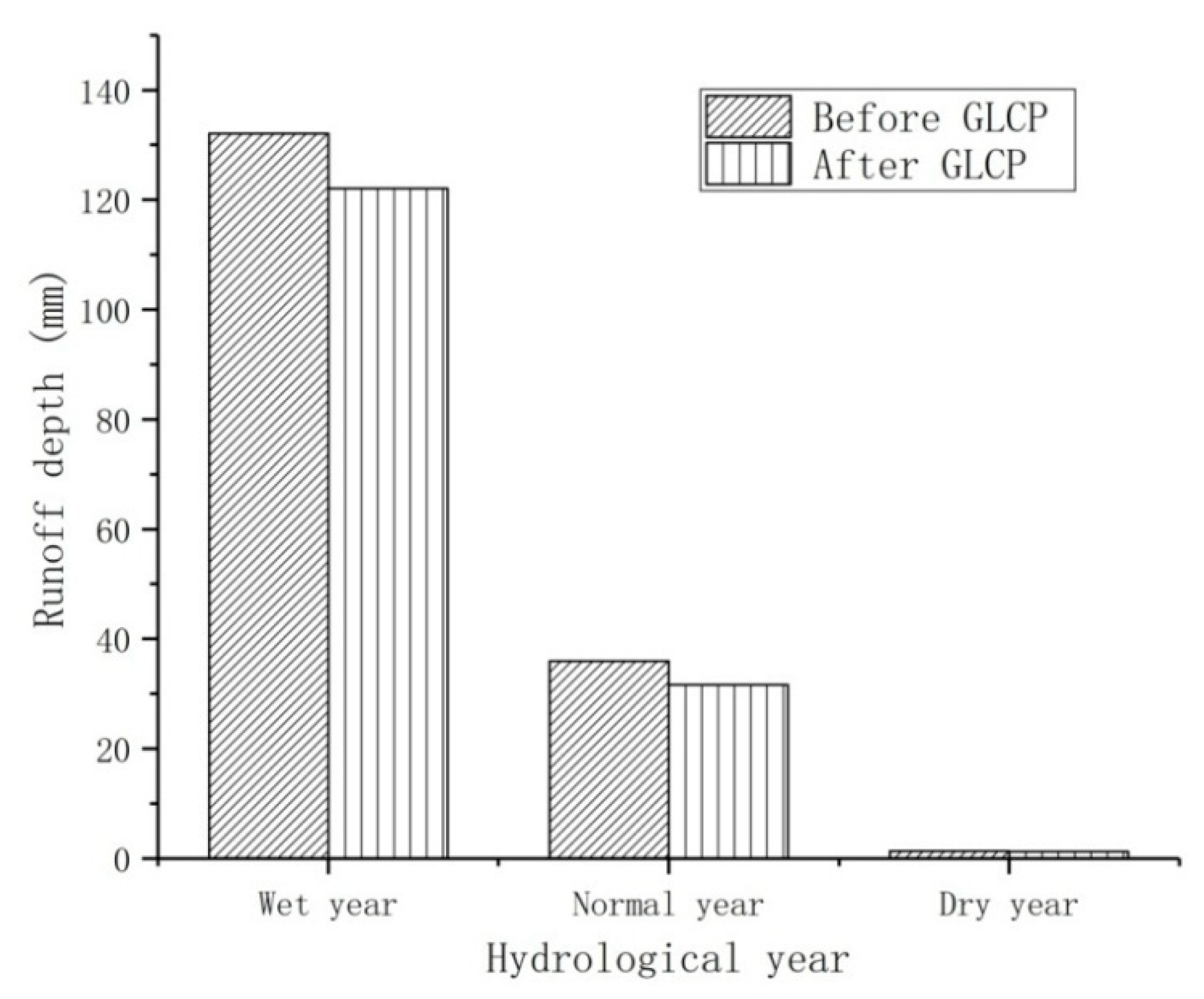
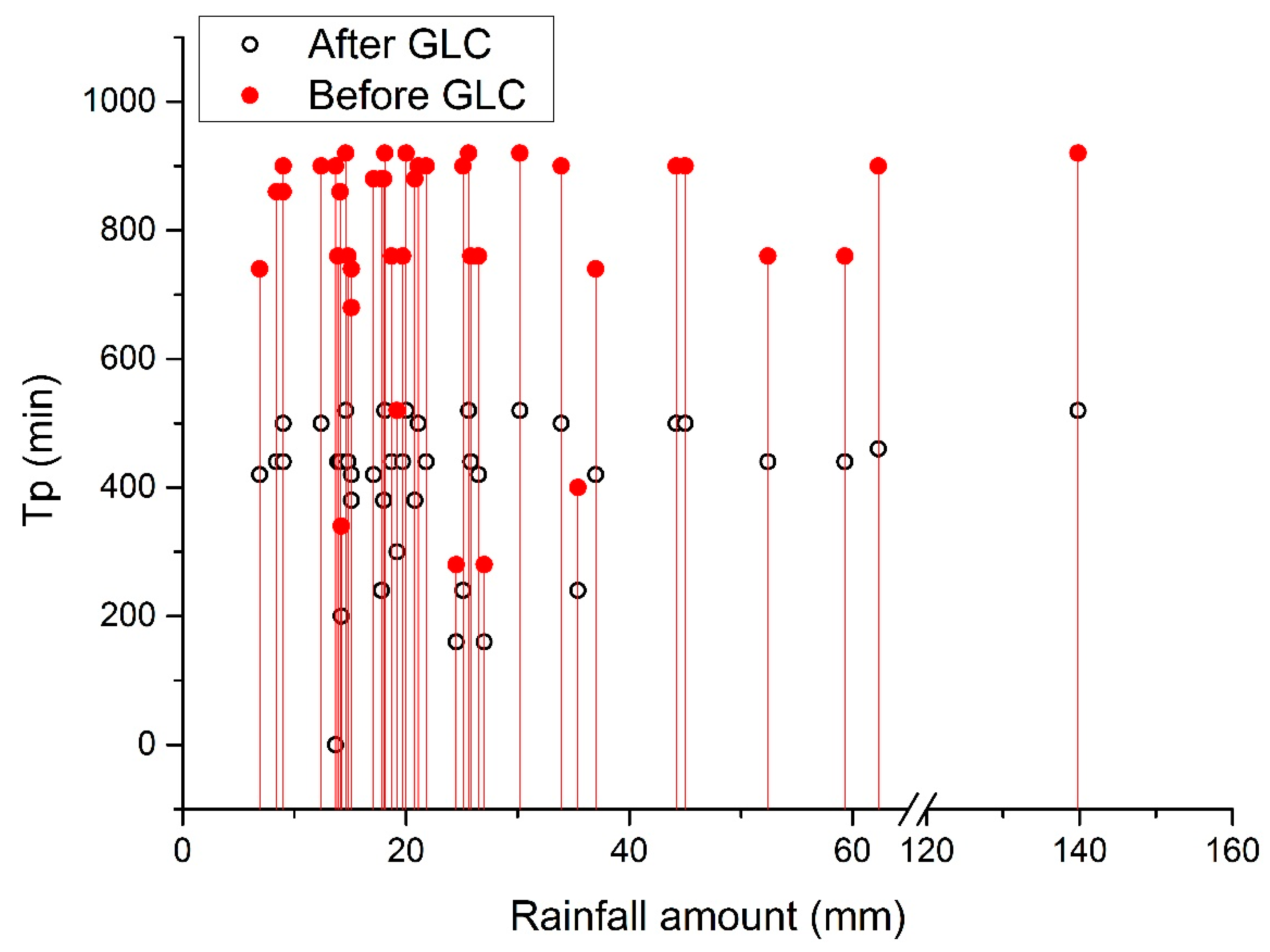

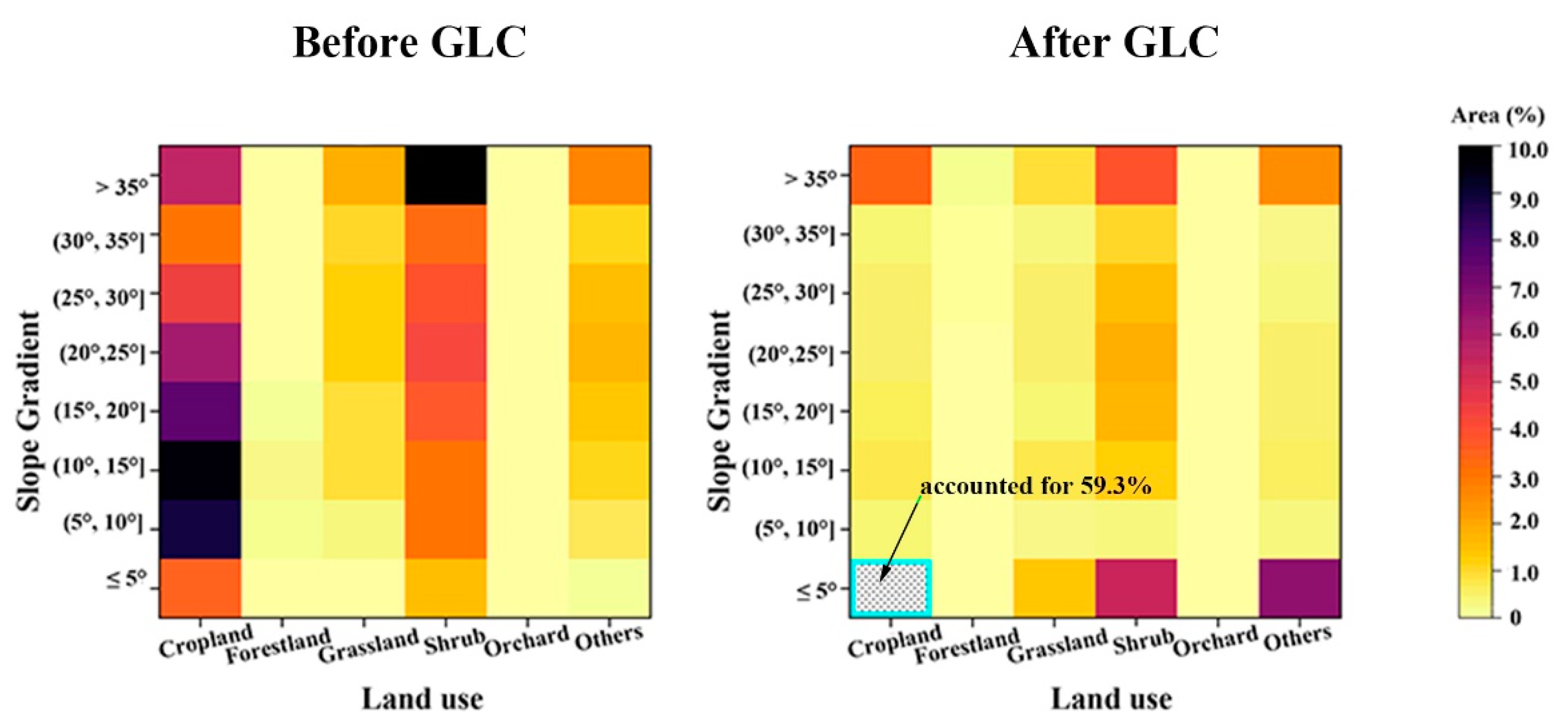

| Precipitation (mm) | P < 10 | 10 ≤ P < 25 | 25 ≤ P < 50 | 50 ≤ P < 100 | P ≥ 100 |
|---|---|---|---|---|---|
| Level | Light rain | Moderate rain | Heavy rain | Rainstorm | Extraordinary storm |
| Date | Precipitation (mm) | Rainfall Intensity (mm/h) | Measured Runoff (mm) | Measured Peak Flow Rate (m3/s) | Measured Time to Peak Flow Rate (min) |
|---|---|---|---|---|---|
| 21 July 2019 | 63 | 4.27 | 0.31 | 0.32 | 140 |
| 1 August 2019 | 75.5 | 41.18 | 11.16 | 16.46 | 160 |
| 3 August 2019 | 54.5 | 2.15 | 4.61 | 5.57 | 630 |
| 19 August 2019 | 38 | 1.43 | 1.31 | 0.19 | 540 |
| 27 August 2019 | 70 | 5.03 | 8.74 | 6.07 | 210 |
| 12 September 2019 | 47 | 2.15 | 2.24 | 0.65 | 420 |
| 5 October 2019 | 32 | 1.72 | 0.91 | 0.09 | 660 |
| Variable | N | T Value | Sig. |
|---|---|---|---|
| RO | 40 | −3.66 | 0.001 |
| Tp | 40 | 17.00 | 0.000 |
| Qp | 40 | −4.29 | 0.000 |
| Rainfall Levels | N | Mean Event Runoff (mm) | |||
|---|---|---|---|---|---|
| Before GLC | After GLC | Absolute Difference (mm) | Relative Difference (%) | ||
| Light rain | 4 | 0.71 | 0.53 | −0.17 | −24.7 |
| Moderate rain | 21 | 0.76 | 0.68 | −0.06 | −10.4 |
| Heavy rain | 11 | 8.01 | 7.51 | −0.49 | −6.2 |
| Rainstorm | 3 | 5.55 | 4.47 | −1.09 | −19.6 |
| Extraordinary storm | 1 | 45.80 | 42.41 | −3.39 | −7.4 |
| Rainfall Level | Wet Year | Normal Year | Dry Year |
|---|---|---|---|
| Light rain | 3 | 1 | 0 |
| Moderate rain | 9 | 5 | 7 |
| Heavy rain | 7 | 4 | 0 |
| Rainstorm | 1 | 2 | 0 |
| Extraordinary storm | 1 | 0 | 0 |
| Rainfall Levels | N | Mean Event Peak Flow Rate (m3/s) | |||
|---|---|---|---|---|---|
| Before GLC | After GLC | Absolute Difference (m3/s) | Relative Difference (%) | ||
| Light rain | 4 | 2.02 | 1.41 | −0.61 | −30.2 |
| Moderate rain | 21 | 1.75 | 1.51 | −0.25 | −14.0 |
| Heavy rain | 11 | 16.27 | 14.95 | −1.31 | −8.1 |
| Rainstorm | 3 | 6.47 | 4.89 | −1.58 | −24.4 |
| Extraordinary storm | 1 | 47.46 | 42.66 | −4.80 | −10.1 |
| Land Use | N | T Value | Sig. | Mean Event Runoff (mm) | |||
|---|---|---|---|---|---|---|---|
| Before GLC | After GLC | Absolute Difference | Relative Difference (%) | ||||
| Cropland | 40 | −3.69 | 0.001 | 7.87 | 4.06 | −3.80 | −48.4 |
| Forestland | 40 | −3.22 | 0.003 | 3.48 | 3.47 | −0.02 | −0.4 |
| Grassland | 40 | −3.38 | 0.002 | 5.38 | 5.17 | −0.20 | −3.8 |
| Shrub | 40 | −4.09 | 0.000 | 4.41 | 4.12 | −0.28 | −6.4 |
| Orchard | 40 | −2.17 | 0.037 | 2.31 | 2.28 | −0.03 | −1.3 |
| Others | 40 | −3.96 | 0.000 | 11.06 | 10.60 | −0.46 | −4.2 |
Publisher’s Note: MDPI stays neutral with regard to jurisdictional claims in published maps and institutional affiliations. |
© 2022 by the authors. Licensee MDPI, Basel, Switzerland. This article is an open access article distributed under the terms and conditions of the Creative Commons Attribution (CC BY) license (https://creativecommons.org/licenses/by/4.0/).
Share and Cite
Wu, G.; Fu, S.; Zhou, G.; Liu, C. Effects of the Gully Land Consolidation Project on Runoff and Peak Flow Rate on the Loess Plateau, China. Water 2022, 14, 2582. https://doi.org/10.3390/w14162582
Wu G, Fu S, Zhou G, Liu C. Effects of the Gully Land Consolidation Project on Runoff and Peak Flow Rate on the Loess Plateau, China. Water. 2022; 14(16):2582. https://doi.org/10.3390/w14162582
Chicago/Turabian StyleWu, Ge, Suhua Fu, Guiyun Zhou, and Chenguang Liu. 2022. "Effects of the Gully Land Consolidation Project on Runoff and Peak Flow Rate on the Loess Plateau, China" Water 14, no. 16: 2582. https://doi.org/10.3390/w14162582
APA StyleWu, G., Fu, S., Zhou, G., & Liu, C. (2022). Effects of the Gully Land Consolidation Project on Runoff and Peak Flow Rate on the Loess Plateau, China. Water, 14(16), 2582. https://doi.org/10.3390/w14162582






